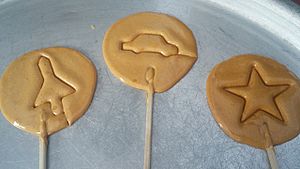Dalgona facts for kids
 |
|
| Alternative names | Ppopgi |
|---|---|
| Type | Sugar candy |
| Place of origin | South Korea |
| Associated national cuisine | Korean cuisine |
| Main ingredients | Sugar, baking soda |
| Similar dishes | Honeycomb toffee |
| Korean name | |
| Hangul |
달고나
|
|---|---|
| Revised Romanization | dalgona |
| McCune–Reischauer | talgona |
| IPA | [tal.ɡo.na] |
| Alternative name | |
| Hangul |
뽑기
|
| Revised Romanization | ppopgi |
| McCune–Reischauer | ppopki |
| IPA | [p͈op̚.k͈i] |
Dalgona (달고나) or ppopgi (뽑기) is a super popular Korean candy! It's made from melted sugar and a tiny bit of baking soda. This sweet treat was a favorite street snack in South Korea during the 1970s and 1980s. Today, people still enjoy it as a fun "retro" food.
When baking soda is mixed into hot, melted sugar, it creates tiny bubbles. These bubbles make the liquid sugar puff up. As it cools, it becomes a light, crunchy candy. Usually, the warm, creamy mixture is poured onto a flat surface. Then, it's pressed flat and stamped with a cool shape, like a star or a circle.
The Dalgona Challenge
One of the most exciting parts of eating dalgona is the challenge! People try to carefully trim around the stamped shape without breaking it. If you can perfectly cut out the shape, you traditionally get another free dalgona candy!
Modern cafes in Korea have also found new ways to use dalgona. They serve drinks like "dalgona coffee," which has a dalgona-flavored coffee cream on top. You can also find dalgona in desserts like bingsu (shaved ice) and souffles.
Dalgona became famous worldwide after appearing in the Netflix show Squid Game. In the show, a deadly version of the dalgona challenge was the second game. The show's huge success made dalgona candy super popular again. Street vendors saw their sales double! Many people also started making dalgona at home and sharing their attempts online.
How Dalgona Got Its Name
The names dalgona and ppopgi were once used for slightly different candies. Dalgona originally referred to more expensive candies made with glucose. These usually didn't have a mold. Ppopgi was for candies made with sugar, which could be easily pressed into shapes.
Over time, dalgona started to mean the same thing as ppopgi. The names for this candy also changed depending on where you were in Korea. For example, in the Gyeonggi Province, including Seoul and Incheon, it was mostly called dalgona or ppopgi.
Regional Names for Dalgona
Different regions had their own unique names for this candy:
- Ttigi (띠기): This name was common in Daejeon and most of the Chungcheong and Jeolla Provinces. It comes from a dialect where the "e" sound changes to "i."
- Gukja (국자): Used mainly in Daegu and North Gyeongsang Province. People called it gukja (which means "ladle") because it was often made in a ladle.
- Jjokja (쪽자): This name was popular in South Gyeongsang Province. It might also be related to the word for "ladle."
- Oritetigi / Orittigi (오리떼기/오리띠기): Used in Masan, this name means "cutting and pulling."
- Ttongi-gwaja (똥과자): In Busan, some people called it ttong-gwaja (poop cookie). This was because of its funny appearance!
- Ttegi (떼기): On Jeju Island, it was called ttegi. In some parts of Seogwipo, it was even called tikka (띠까).
In the past, before smartphones and media were everywhere, these regional names were very common. But now, with more media influence from areas like Seoul, most middle and high school students just call it dalgona.
Gallery
-
Making dalgona on yeontan (coal briquettes)
See also
 In Spanish: Dalgona para niños
In Spanish: Dalgona para niños






